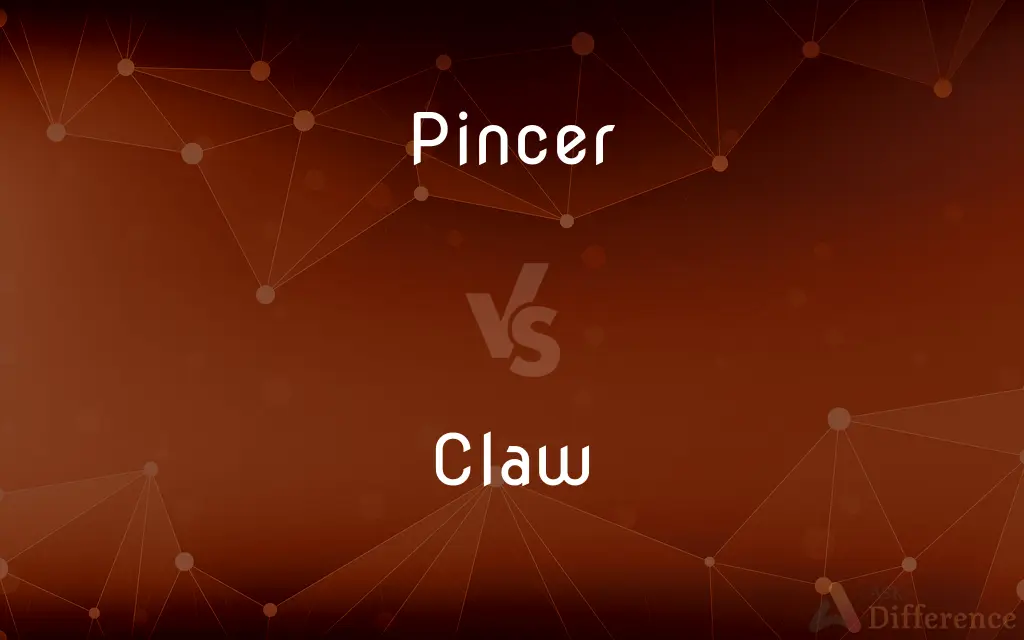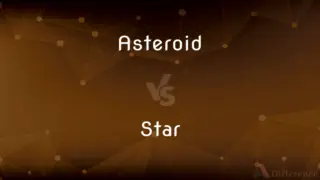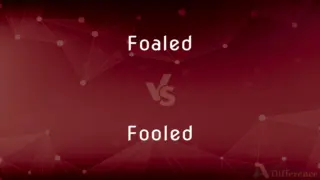Pincer vs. Claw — What's the Difference?
Edited by Tayyaba Rehman — By Fiza Rafique — Updated on March 18, 2024
Pincers are tools or body parts resembling tongs, used for gripping or pinching, while claws are sharp, curved nails on animals, used for grasping or tearing.

Difference Between Pincer and Claw
Table of Contents
ADVERTISEMENT
Key Differences
Pincers, in many contexts, refer to tools designed for gripping, pinching, or compressing objects, often used in various mechanical and crafting applications to manipulate materials. On the other hand, claws are natural extensions of an animal's body, typically found on the toes or fingers of various species, including cats, birds, and reptiles. Claws serve primarily as hunting or defensive tools, enabling animals to catch prey, climb, or offer protection against predators. This distinction underscores the difference in application and function between man-made instruments and natural adaptations.
While pincers are characterized by their mechanical function, claws are often noted for their biological significance. Pincers, whether part of an animal's anatomy like those of a crab or lobster or a human-made tool, operate through a scissor-like action to grasp, lift, or crush. In contrast, claws are integrated into an animal's physiology, growing from the fingertips and capable of being sharpened or retracted in some species.
Pincers and claws also differ in their structural composition and maintenance. The material makeup of pincers, especially those that are tools, includes metals, plastics, or other durable materials suited to their specific usage, requiring regular maintenance such as cleaning and sharpening to ensure their effectiveness. Meanwhile, claws, being organic, are composed of keratin, a protein that also makes up human hair and nails. Animal claws grow continuously and are naturally maintained through wear and tear or specific behaviors, such as scratching for cats, which helps to keep them sharp and ready for use.
The symbolism associated with pincers and claws also highlights their distinct connotations. Pincers, due to their function and design, are often seen as symbols of craftsmanship, precision, and the ability to manipulate or control one's environment. Claws, however, carry a primal symbolism, often representing ferocity, survival, and the raw power of nature. They evoke images of predators and the struggle for life in the wild, symbolizing strength, agility, and the instinctual aspects of existence.
The cultural representations and metaphors surrounding pincers and claws further reflect their differing roles and perceptions. Pincers, in literature and media, may symbolize the human capacity for innovation and adaptation, illustrating themes of problem-solving and technical skill. Conversely, claws are frequently depicted in myths, legends, and popular culture as attributes of monsters or heroic animals, embodying the themes of bravery, wilderness, and the untamed aspects of the world. These representations play into broader narratives about the contrast between human society and the natural world, emphasizing the unique roles that pincers and claws play in human and animal life, respectively.
ADVERTISEMENT
Comparison Chart
Definition
A tool or part resembling tongs for gripping.
A sharp, curved nail on the toe of an animal.
Usage
Gripping, pinching, or manipulating materials.
Hunting, climbing, or defense.
Composition
Metal, plastic (tools); organic materials (animals).
Keratin.
Maintenance
Regular cleaning, sharpening.
Natural wear, behaviors like scratching.
Symbolism
Craftsmanship, precision, control.
Ferocity, survival, raw power of nature.
Compare with Definitions
Pincer
A part of an animal's body used for capturing prey or defense, resembling mechanical pincers.
The crab's pincers snapped shut on the stick.
Claw
A grappling technique in martial arts that resembles the use of an animal's claw.
He applied the claw hold to immobilize his opponent.
Pincer
Used metaphorically to describe a situation of tight control or manipulation.
She felt caught in the pincers of corporate politics.
Claw
A sharp, curved nail found on animals such as cats and birds.
The eagle's claws gripped the branch firmly.
Pincer
A culinary tool used for handling or preparing food.
He used kitchen pincers to flip the steak on the grill.
Claw
Used metaphorically to describe control, aggression, or the act of grasping.
The company's claws reached into every part of the industry.
Pincer
A tool or instrument for gripping or pinching items.
The jeweler used a pincer to carefully place the gemstone.
Claw
A part of machinery or equipment that grasps or holds things, inspired by animal claws.
The arcade game featured a claw that attempted to grab prizes.
Pincer
In some sports, a maneuver or technique that involves a pinching action.
In wrestling, he used a pincer move to gain leverage.
Claw
In fashion, a type of jewelry or accessory that mimics the shape of a claw.
She wore a claw-shaped pendant around her neck.
Pincer
A tool made of two pieces of metal with blunt concave jaws that are arranged like the blades of scissors, used for gripping and pulling things.
Claw
A claw is a curved, pointed appendage found at the end of a toe or finger in most amniotes (mammals, reptiles, birds). Some invertebrates such as beetles and spiders have somewhat similar fine, hooked structures at the end of the leg or tarsus for gripping a surface as they walk.
Pincer
A hinged and sharply pointed organ used by an arthropod for feeding or defence, as the mandibles of an insect, or each of the chelae of a crab, lobster, or scorpion.
Claw
A curved pointed horny nail on each digit of the foot in birds, lizards, and some mammals.
Pincer
Often pincers or pinchers A grasping tool having two parts hinged together to work in opposition.
Claw
Scratch or tear something with the claws or the fingernails
The kitten was clawing at Lowell's trouser leg
Her hands clawed his shoulders
Pincer
One of the opposing parts in such a tool.
Claw
(of a sailing ship) beat to windward
The ability to claw off a lee shore
Pincer
A claw resembling such a tool, as of a lobster or scorpion; a chela.
Claw
A sharp, curved, horny structure at the end of a toe of a vertebrate animal.
Pincer
Pincers or pinchers A pair of mandibles or other appendages used by certain arthropods for grasping, as the cerci of an earwig.
Claw
A chela or similar pincerlike structure on the end of a limb of a crustacean or arachnid.
Pincer
A military maneuver in which an enemy force is attacked from two flanks and the front.
Claw
One of one or more small curved structures at the tip of an appendage of an invertebrate, especially an insect or other arthropod.
Pincer
Any object that resembles one half of a pair of pincers.
Claw
A limb terminating in such a structure.
Pincer
To surround with a pincer attack.
Claw
Something, such as the cleft end of a hammerhead, that resembles a claw.
Pincer
A hand tool for holding consisting of a compound lever
Claw
(Botany) A narrowed, stalklike basal part of a petal, sepal, or bract.
Pincer
A structure like a pincer on the limb of a crustacean or other arthropods
Claw
To scratch, dig, tear, or pull with the claws or fingernails.
Claw
A curved, pointed horny nail on each digit of the foot of a mammal, reptile, or bird.
Claw
A foot equipped with such.
Claw
The pincer (chela) of a crustacean or other arthropod.
Claw
A mechanical device resembling a claw, used for gripping or lifting.
Claw
(colloquial) A human fingernail, particularly one extending well beyond the fingertip.
Claw
(botany) A slender appendage or process, formed like a claw, such as the base of petals of the pink.
Claw
(juggling) The act of catching a ball overhand.
Claw
To scratch or to tear at.
Claw
To use the claws to seize, to grip.
Claw
To use the claws to climb.
Claw
(juggling) To perform a claw catch.
Claw
To move with one's fingertips.
Claw
To relieve an uneasy feeling, such as an itch, by scratching (someone or something); hence (figuratively), to flatter or humour (someone); to court, to fawn on.
Claw
To rail at, revile, or scold (someone or something).
Claw
To do (something) quickly.
Claw
A sharp, hooked nail, as of a beast or bird.
Claw
The whole foot of an animal armed with hooked nails; the pinchers of a lobster, crab, etc.
Claw
Anything resembling the claw of an animal, as the curved and forked end of a hammer for drawing nails.
Claw
A slender appendage or process, formed like a claw, as the base of petals of the pink.
Claw
To pull, tear, or scratch with, or as with, claws or nails.
Claw
To relieve from some uneasy sensation, as by scratching; to tickle; hence, to flatter; to court.
Rich men they claw, soothe up, and flatter; the poor they contemn and despise.
Claw
To rail at; to scold.
In the aforesaid preamble, the king fairly claweth the great monasteries, wherein, saith he, religion, thanks be to God, is right well kept and observed; though he claweth them soon after in another acceptation.
Claw
To scrape, scratch, or dig with a claw, or with the hand as a claw.
Claw
Sharp curved horny process on the toe of a bird or some mammals or reptiles
Claw
A mechanical device that is curved or bent to suspend or hold or pull something
Claw
A structure like a pincer on the limb of a crustacean or other arthropods
Claw
A bird's foot that has claws
Claw
Move as if by clawing, seizing, or digging;
They clawed their way to the top of the mountain
Claw
Clutch as if in panic;
She clawed the doorknob
Claw
Scratch, scrape, pull, or dig with claws or nails
Claw
Attack as if with claws;
The politician clawed his rival
Common Curiosities
Are all claws sharp and curved?
Most claws are sharp and curved to aid in hunting, climbing, or defense, though the exact shape can vary among species.
How do animals maintain their claws?
Animals maintain their claws through natural behaviors like scratching, which helps keep them sharp and clean.
Can humans have claws?
Humans do not have claws; they have nails, which are similar in composition to claws but flat and not curved or sharp for grasping.
How do pincers differ in various species of animals?
Pincers can vary in size, strength, and functionality among species, adapting to different environmental and survival needs.
Can pincers be found on animals?
Yes, many crustaceans like crabs and lobsters have pincers as part of their anatomy for defense and handling food.
Is the maintenance of pincers similar in tools and animals?
Maintenance differs; tools require manual care, while animal pincers are maintained through natural behavior and use.
Can pincers be used for delicate tasks?
Yes, pincers, especially those designed as tools, can be used for delicate tasks requiring precision, such as jewelry making.
Do claws serve any purpose other than for defense or hunting?
Claws also assist in locomotion, such as climbing, and can be used in social interactions or displays within species.
Do claws grow back if they are damaged or lost?
Claws can regrow over time if damaged, but the ability to fully regenerate depends on the species and the extent of the injury.
Are pincers considered a primitive feature in animals?
Pincers are not necessarily primitive but are specialized adaptations for specific ecological niches and survival strategies.
Are there any cultural taboos associated with pincers or claws?
Cultural perceptions vary, but there are no widespread taboos specifically associated with pincers or claws, though they may feature in myths or superstitions.
Can claws be blunt?
Claws may become blunt due to wear or age but are generally kept sharp through natural behaviors.
Are pincers and claws found in all animals?
No, pincers and claws are specific to certain animal groups, such as crustaceans for pincers and mammals, birds, and reptiles for claws.
Can claws be a fashion inspiration?
Yes, claws often inspire jewelry, accessories, and fashion designs, symbolizing strength and ferocity.
Are pincers ever used as surgical tools?
Yes, pincer-like instruments are used in surgery for gripping and manipulating tissues delicately.
Share Your Discovery

Previous Comparison
Asteroid vs. Star
Next Comparison
Foaled vs. FooledAuthor Spotlight
Written by
Fiza RafiqueFiza Rafique is a skilled content writer at AskDifference.com, where she meticulously refines and enhances written pieces. Drawing from her vast editorial expertise, Fiza ensures clarity, accuracy, and precision in every article. Passionate about language, she continually seeks to elevate the quality of content for readers worldwide.
Edited by
Tayyaba RehmanTayyaba Rehman is a distinguished writer, currently serving as a primary contributor to askdifference.com. As a researcher in semantics and etymology, Tayyaba's passion for the complexity of languages and their distinctions has found a perfect home on the platform. Tayyaba delves into the intricacies of language, distinguishing between commonly confused words and phrases, thereby providing clarity for readers worldwide.














































